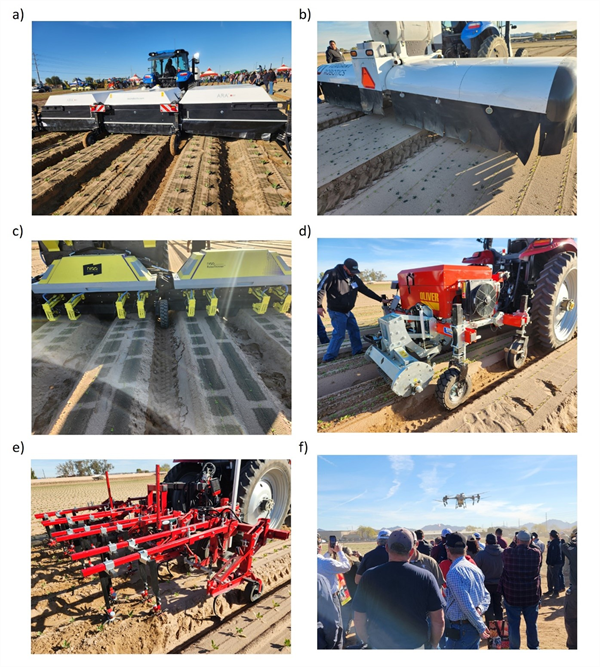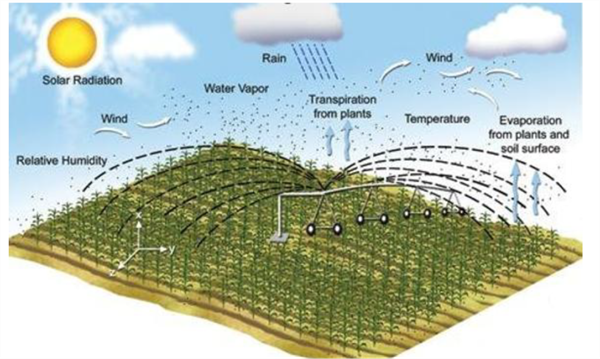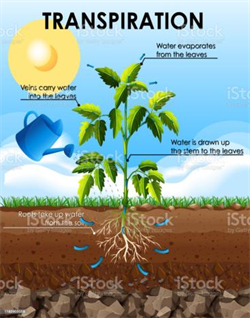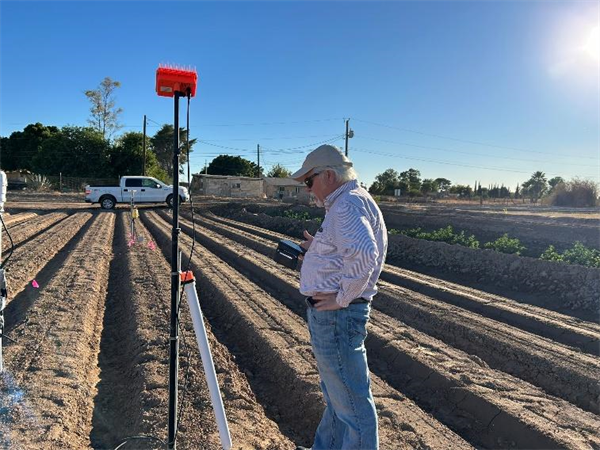
In the last issue of this UA Vegetable IPM Newsletter, I presented a melon (Cucumis melo ‘reticulatus’ L.) crop phenology model (Figure1; Silvertooth, 2025). This model can be useful in predicting and tracking crop development and identifying important stages of crop growth and development (crop phenology).
Use of a crop phenology model can be applied to basic crop management (e.g. fertilization, irrigation, harvest scheduling, pest management activities, labor, and machinery management, etc.). For use of the crop phenology model, good local weather data with heat unit information is needed. In Arizona we have an excellent weather system with the Arizona Meteorological Network, AZMET.
Since cantaloupes are a warm season crop, we use the86/55 ºF heat unit (HU) thresholds for phenological tracking. Key stages of growth or “guideposts” indicated in Figure 1represent the average or “target” values that are subject to a slight degree of natural variation, which is normal.
This melon crop phenology model was developed under fully irrigated and well-managed conditions. That is important since non-irrigated fields are more likely to experience water stress, which significantly disrupts crop development patterns.
Referring to the data from AZMET for several locations in the Yuma area, the HU accumulations (86/55 ºF thresholds) from 1 January 2025 to a set of four possible 2025 planting dates are listed in Table 1. The HU accumulations from 1 January2025 to 15 April 2025 for these sites are listed in Table 2.
The HU accumulations after planting (HUAP) for these four possible planting dates for three Yuma area locations to 15 April 2025 are shown in Table 3. The HUAP values in Table 3 are simply the difference between the values in Tables 1 and 2. An example for the Yuma Valley, 15 January 2025planting date is: HU - 73.1 HU = 645.6 ~ 646 HUAP.
The information in Table 3 can help serve as a reference to check for melon crop development in the field against this phenological model in Figure 2. Several cantaloupe/melon types are being in this region including western shipper type melons, Tuscan melons, and Hami melons. In the past, each of these melon types have tracked closely with this phenological model.
For melon crops in the lower Colorado River Valley at this time, we can expect to find fields planted and watered up in mid-January to have crown set melons beginning to develop netting, which may not be as apparent on the Hami melons. These fields could have crown fruit ready for harvesting in about three weeks, based on normal HU accumulation patterns for this time of year. For fields planted and wet dates near the first of March, these fields should be vigorously flowering.
Reference:
Silvertooth, J.C. 2025. Tracking Cantaloupe (Melon) Crop Growth and Development. University of
Arizona Vegetable IPM Newsletter, Volume 16, No.7, 2 April 2025.

Table 1. Heat unit accumulations (86/55 ºF thresholds) after 1 January 2025 on four possible 2025 planting dates utilizing Arizona Meteorological Network (AZMET) data for each representative site.
Yuma Valley: https://azmet.arizona.edu/application-areas/heat-units/station-level-summaries/az02
Yuma North Gila: https://azmet.arizona.edu/application-areas/heat-units/station-level-summaries/az14
Roll: https://azmet.arizona.edu/application-areas/heat-units/station-level-summaries/az24

Table 2. Heat unit accumulations (86/55 ºF thresholds) after 1 January 2025 to 14 April
2025 utilizing Arizona Meteorological Network (AZMET) data for each representative site.

Table 3. Heat unit accumulations (86/55 ºF thresholds) after planting (HUAP) from four
possible 2025 planting dates and three sites in the Yuma area on 15 April 2025 utilizing
Arizona Meteorological Network (AZMET) data for each representative site. Each value
is rounded to the next whole number. Note: the values in Table 3 are determined by
taking the difference between the HUs foreach representative site and four planting
dates in Tables 1 and 2.

Figure 1. Melon (cantaloupe) phenological development model expressed in Heat Units
Accumulated After Planting (HUAP, 86/55°F).
At the 2025 Southwest Ag Summit Field Demo a couple of weeks ago, many of the latest technologies were demonstrated in the field. Most were related to pest control. Several of the technologies demonstrated are new to the Yuma, AZ area. The recent technologies presented included two types of high precision spot sprayers for weeding and applying beneficial pesticides (Fig. 1a, Fig. 1b) and an AI based lettuce thinner. Manufacturers stated the technologies will be getting even better/more versatile soon. Both precision spot sprayer companies are developing models for small lettuce so that the machines can also be used for lettuce thinning. Also new was that the AI lettuce thinner technology is being further developed so that the device can be used also be used as a weeder. Several “older” pest control technologies also seemed to garner a lot of interest. These included an implement designed for cultivating high density crops (Fig. 1d), a camera guided cultivator equipped with in-row weeding tools (Fig. 1e) and a field scale drone sprayer (Fig. 1f).

Fig. 1. Newer pest control technologies demonstrated at the 2025 Southwest Ag Summit
Field Demo included a) Ecorobotix1 Ara high precision spot sprayer, b) Verdant Robotics
Sharp Shooter, c) Niqo Robotics AI based lettuce thinner, d) Oliver high density
cultivator, e) Steketee IC Light camera guided cultivator and f) DJI Agras T50 drone
sprayer.
There are more than 50 broadleaf and grass weeds in this area that are common and have been here for a long time. It would be great to have an herbicide that will control all of them, be safe to the crop and be gone the next day after harvest.
Obviously, we are a long way from achieving this. What we have done instead is select for the weeds that escape our weed control practices. Anything that shifts the advantage to the crop instead of the weeds will help. Our practices include the use of herbicides, mechanical techniques and hand hoeing. Good weed control can be achieved using all three but may not be economical.
Weed selection due to herbicide availability was evident a few years ago when leaf lettuce was removed from the Kerb label in 2009. It is well known that Kerb, Prefar and Balan were the standard herbicides used in lettuce for the last 60years. Kerb will control the grasses and most of the broadleaves consistently including many that are not controlled by the other two products such as shepherds purse, london rocket and wild mustard. The longer that Kerb was unavailable the more prevalent some weeds would become. On January 12, 2016, the EPA label for Kerb was reinstated for leaf lettuce bringing back the tool to the industry1.
Prefar will control grass consistently, purslane and pigweed most of the time, lambs quarters and goosefoot some of the time. Balan will control grass consistently and many of the small-seeded broadleaves some of the time.
The postemergence grass herbicides were registered about 30 years ago but for broadleaf weeds there has not been a new registration in half a century.

Reference:
1. Retrieved from the www on Oct 14, 2024 https://ucanr.edu/blogs/blogcore/postdetail.cfm?postnum=21270#:~:text=On%20January%2012%2C%202016%20the%20Federal%20EPA,55%20day%20prior%20to%20harvest%20(Table%201).
2. https://cales.arizona.edu/crop/vegetables/advisories/more/weed122.html
Western Flower thrips is among the most economically important insect pests that infests desert lettuce. Bean thrips started to become a major pest of fall lettuce in the desert over the last decade. Our objective is to determine alternative organic insecticides that can be used as part of an IPM program targeting these pests in leafy vegetable crops.
This fall, at the YAC experimental farm, we evaluated 10 organic insecticides frothier efficacy in suppressing western flower thrips and bean thrips in organic head lettuce. M-Pede, Pyganic, and Aza-Direct were evaluated with Oroboost included in one treatment and Orbit DL included in the other treatment. Thus, we evaluated these aforementioned insecticides in two different treatment entries. The purpose was to understand the performance of these insecticides with Orbit DL or Oroboost as adjuvant. The remaining insecticide treatments had only Oroboost as adjuvant. Both Oroboost and Orbit DL are OMRI approved organic adjuvants.
We expected that several of these bioinsecticides would exhibit some measurable level of thrips suppression. However, our data showed that only Entrust exhibited measurable reduction in immature thrips, western flower thrips, and bean thrips numbers (Fig. 1-3). Gargoil and Pyganic with the Orbit as adjuvant exhibited a slight reduction in western flower thrips adults (Fig. 2). We will continue to evaluate these organic insecticides against the thrips to gather more research-based evidence which will allow us to draw more accurate conclusions and make relevant recommendations.

Figure 1. Mean thrips nymph/plant as affected by organic insecticide application.
DAT=Day After Treatment.

Figure 2. Mean western flower thrips adult/plant as affected by organic insecticide
application. DAT=Day After Treatment.

Figure 3. Mean bean thrips adult/plant as affected by organic insecticide application.
DAT=Day After Treatment.
The combination of two separate processes whereby water is lost on the one hand from the soil surface by evaporation and on the other hand from the crop by transpiration, is referred to as evapotranspiration (ET). Evaporation is the process whereby liquid water is converted to water vapor (vaporization) and removed from the evaporating surface (vapor removal). Water evaporates from a variety of surfaces, such as lakes, rivers, pavements, soils, and wet vegetation. Energy is required to change the state of the molecules of water from liquid to vapor. Direct solar radiation and, to a lesser extent, the ambient temperature of the air provide this energy (Fig:1).

Figure 1: Key factors driving ET in agriculture include solar radiation, temperature, wind,
humidity, and plant and soil water loss.
Transpiration consists of the vaporization of liquid water contained in plant tissues and the vapor removal to the atmosphere. Crops predominantly lose their water through stomata. These are small openings on the plant leaf through which gases and water vapor pass. The water, together with some nutrients, is taken up by the roots and transported through the plant (Fig: 2).

Figure 2: A diagram illustrates the process of transpiration in plants, where water is
absorbed by roots, moves through the stem, and evaporates from the leaf surfaces.
Why evapotranspiration (ET)?
ET is the largest component of the hydrological cycle and is one of the most critical variables in irrigation management, crop production, and the sustainability of agriculture. It has a direct impact on water resources availability and use, water quality, and the earth’s energy balance. Daily evapotranspiration (ET) rates are needed for irrigation scheduling. The evapotranspiration rate is normally expressed in millimeters (mm) or inches (in) per unit of time (e.g., an hour, day, week, month, or even an entire growing period or year).
Reducing evapotranspiration (ET) can lead to significant water savings by minimizing unnecessary water loss through soil evaporation and plant transpiration. By applying irrigation more efficiently only when and where it's needed, plants can maintain optimal moisture levels, reducing stress and promoting better growth. This can enhance nutrient uptake, improve plant health, and ultimately lead to higher yields. Moreover, conserving water through reduced ET is especially critical in arid regions, where freshwater resources are limited, and efficient water use is essential for sustainable agricultural production.
Below are strategies to reduce ET

Figure 3: Figure 3. Soil moisture sensor installation at the Valley Research Center,
Yuma, AZ.